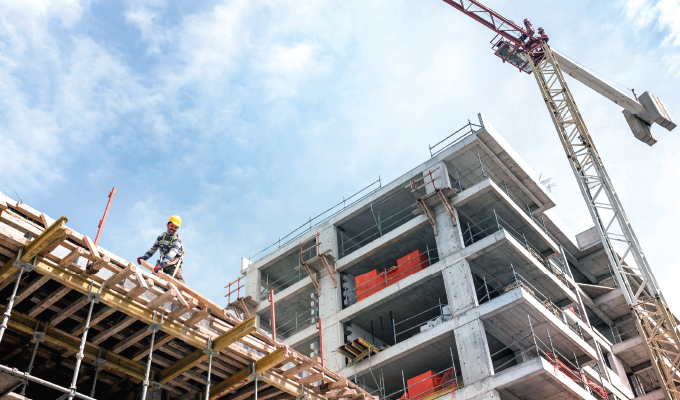Last year, lawmakers in Washington passed a massive $1.2 trillion bipartisan infrastructure plan which represents the most significant investment in highways, ports, and other critical projects for years to come. But new and old challenges raise questions about whether contractors and subcontractors have the tools they need to take advantage of these opportunities as they are already struggling to find resources in a tight market. Supply chain challenges are dominating the news, but the truth is no industry has been hit harder than construction.
PROJECTS AND COSTS
Over the course of 2 years, material costs skyrocketed and lead times increased, forcing contractors to pay significantly more out of pocket to procure materials. According to one recent study, during the last 18 months, lumber costs increased 122%, steel mill products 123%, copper and wire cable 101%, and diesel fuel 201%, while demand continues to rise.
In Maryland, a 16-mile swath of construction sites has sat abandoned since October 2020. The Purple Line light-rail project is now 4½ years behind schedule and will cost an additional $1.4 billion to build under a proposed contract to complete.
Maryland Transit Administration says the contractor’s claims of $850 million in cost overruns stopped work on the line didn’t reflect dramatic pandemic-era construction cost increases, such as for materials and insurance, or the pandemic’s severe effects on the labor pool and supply chain.
PROJECTS AND PEOPLE
While lack of materials is clearly a significant challenge for commercial and residential builders, an equally large challenge has increased in prevalence: the multiple impacts of a worsening labor shortage. As with material costs, the post-COVID labor crisis impacts nearly every industry and has severely added to long-standing construction staffing woes. According to the U.S. Chamber of Commerce Commercial Construction Index (CCI), over 90% of commercial contractors reported some level of difficulty finding skilled workers, but 62% indicated high levels of difficulty—a 7% jump from Q3. Pandemic-related project delays have also increased, with two-thirds (66%) of contractors expecting delays on some projects. This difficulty in finding workers is straining contractors’ bottom lines.
Unlike other industries, simply offering higher pay is not a viable, long-term solution. First, the average hourly construction wage is already 46% higher than the average $11.26 hourly U.S. wage. President Joe Biden’s executive order raising the federal contractor minimum wage from $10.95 to $15 an hour with a January 30, 2022, deadline is set to have little impact. Second, 73% of contractors reported they have already increased base pay rates during the past year, with little success in reducing the shortage. Finally, housing and commercial costs are already soaring due to pent-up demand, scarcity, and high material costs. Adding more wage increases into the mix will only further raise those costs, decimate small contractors with limited resources, and ultimately lead to significantly higher prices for consumers.
PROJECTS AND PAYMENTS
As with most construction industry issues, the burden of dealing with these twin challenges falls on subcontractors, who must pay for rising material and labor costs upfront, all before they are paid for their work. With narrow and declining margins, inconsistent or unavailable cash flow, and limited financing options, subcontractors are tapped out and have little flexibility if complications arise.
Today, subcontractors sit at the bottom of the payment stream. Subcontractors are typically the last to get paid, often waiting 60-90 days to be paid for completed work. Relying on cash on hand is far too unpredictable to comfortably pay for labor or materials upfront, much less reliably finance the sizable expenses that come with scaling a business. In fact, the lack of reliable funds significantly increases a subcontractors’ risk of losing a project and ultimately increases project risk for property owners and general contractors. New, reliable labor advance financing has become available and helps ensure subcontractors have the liquidity to pay their crew on time and deliver successful results.
PROJECTS AND FINANCING
Younger, growing businesses typically have a more difficult time securing the financing needed to succeed, while more established subcontractors may have access to some of these financing options. Fortunately, new alternatives are finally entering the marketplace to combat rising labor costs in the construction industry and the taxing impact on subcontractor cash flow and overall liquidity of commercial construction projects.
Significant stress is often put on a contractor’s business when they must dig into their pockets to pay for labor, as they are often not paid on time. As labor costs have spiked, pay advance options can stabilize cash flow and help subcontractors continue to grow their business. These effective solutions provide subcontractors same-day financing on completed work with approved pay apps, eliminating the subcontractor’s responsibility to float their own capital to fund projects and pay their workers. Complete solutions on the market give commercial subcontractors access to financing for the two largest expenses on a project—materials and labor—and ensure the resources and purchasing power they need to not only remain liquid throughout the entire project, but also to take control of their cash flow and grow their business.
CLOSING THOUGHT
Subcontractors are being hammered by skyrocketing material financing costs and the detrimental impacts of the construction labor shortage. With no signs of demand slowing and few options to quickly increase the number of workers, subcontractors need new, reliable options to help bridge the gap in their outgoing funding responsibilities and incoming cash flow. Pay advance options are a critical new tool that can help subcontractors pay for the workers they need to ensure projects are completed and to lay the foundation for future growth and success.
About the Author:
Christopher Doyle is an entrepreneur and business leader with extensive construction industry experience and a record of launching successful startups. He is the co-founder and CEO of Billd, a disruptive payment solution for the construction industry that helps contractors and suppliers grow their businesses with less hassle and risk. For more, visit billd.com.
Modern Contractor Solutions, February 2022
Did you enjoy this article?
Subscribe to the FREE Digital Edition of Modern Contractor Solutions magazine.



